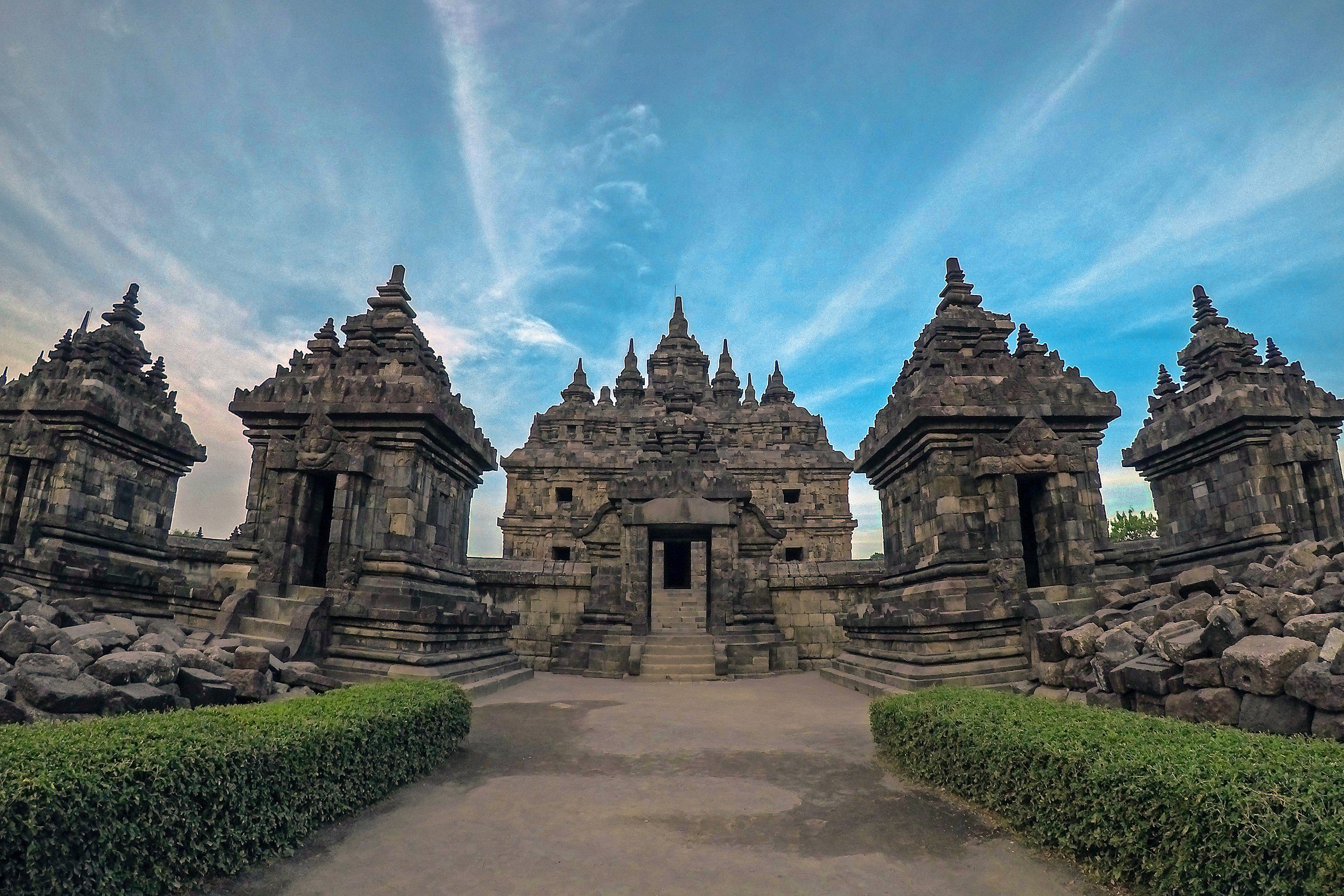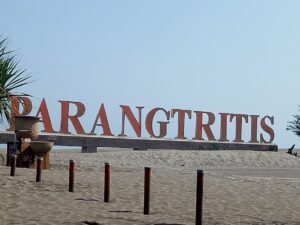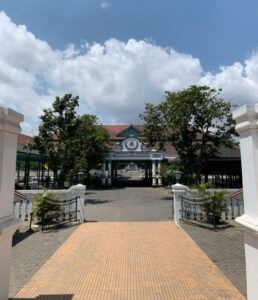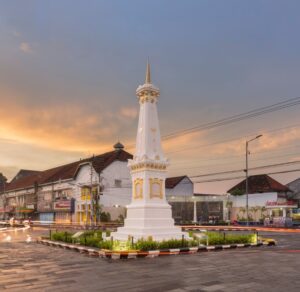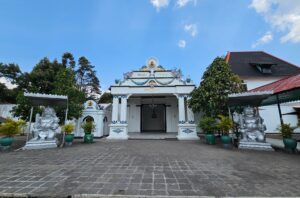Plaosan Temple Complex, located in Dukuh Plaosan, Bugisan Village, Prambanan Subdistrict, Klaten Regency, Central Java Province, Indonesia, is about a kilometer northeast of Sewu Temple or Prambanan Temple.
The presence of stupas, Buddha statues, and smaller accompanying shrines in the form of stupas indicates that these temples are of the Buddhist tradition.
It was constructed in the 9th century by King Rakai Pikatan and Sri Kahulunan during the era of the Medang Kingdom, also known as the Ancient Mataram Kingdom.
The Plaosan Temple Complex consists of Plaosan Lor and Plaosan Kidul. In the past, the temple complex was surrounded by a rectangular-shaped moat, remnants of which are still visible today on the east and west sides of the temple.
Plaosan Temple is not just a historic site; it’s also a spot for educational and religious tourism in Central Java. Here’s more history of Plaosan Temple from Yogyakarta Tours
Plaosan Temple History
Quoting from Otto Sukatno’s book, “Kitab Para Raja,” Candi Plaosan is an ancient complex divided into two parts: Candi Plaosan Lor and Candi Plaosan Kidul. A road and rice fields separate these complexes.
According to experts, Candi Plaosan was constructed during the reign of Rakai Pikatan from the Ancient Mataram Kingdom, estimated around the 9th century AD. Rakai Pikatan built Candi Plaosan for his wife, Pramodhawardhani, in a unique historical context where they belonged to different religions. While Rakai Pikatan followed Hinduism, Pramodhawardhani was a Buddhist.
Their interfaith marriage faced opposition from both families, but they went to great lengths to seek approval, and one significant gesture was the construction of Candi Plaosan.
The temple, a blend of Buddhist and Hindu architecture, was a testament to Rakai Pikatan’s love for Pramodhawardhani. Eventually, their families accepted and blessed their union.
As mentioned, Candi Plaosan is often chosen as a pre-wedding photoshoot location. This is rooted in the belief that couples visiting this site will have a lasting and prosperous relationship.
Plaosan Lor Temple
The Plaosan Lor Temple Complex features two main temples.
The temple on the left (north side) is called the North Main Temple, with reliefs depicting female figures, while the temple on the right (south side) is called the South Main Temple, with reliefs depicting male figures.
In the northern part of the complex, there is an open mandapa with several Buddhist statues. Both main temples surround 116 perwara stupas, 50 perwara shrines, and artificial moats.
Each main temple contains 6 statues/icons of Dhyani Bodhisattvas. Despite being a Buddhist temple, its architectural style is a blend of both Buddhist and Hindu influences.
The South Main Temple of Plaosan Lor was restored in 1962 by the Archaeological Department, while the North Main Temple was restored in the 1990s by the Central Java Historical and Archaeological Heritage Preservation.
Temple Architecture
These days, the temple serves as a tourist spot, offering both leisure and knowledge. When you go there, it’s important to maintain a respectful attitude and avoid littering.
This tourist destination boasts incredibly Instagrammable photo spots within its extensive and explorable temple grounds. You’ll find a picturesque arrangement of stones from the perwara temple on one side. Here’s a glimpse of its architecture:
1. Fusion of Buddha and Hindu Styles
This temple is divided into the north (lor) and the south (kidul). The terrace takes on a square shape and is surrounded by walls. There’s a spot for meditation, a kind of pavilion.
2. Often Referred to as Twin Temples
The structures in the lor and kidul sections are quite similar, earning them the nickname “twin temples.” So, when you visit, from a distance, these two temples appear to share a similar architectural style.
Location
Candi Plaosan is in Plaosan Lor, Bugisan, Prambanan Sub-district, Klaten Regency, Central Java. Its location is quite strategic, making it easy to find. You can visit Candi Plaosan using either private or public transportation.
If you opt for public transport, you can take the TransJogja bus to Candi Prambanan. Then, continue your journey to Candi Plaosan by motorcycle taxi.
However, for a more convenient option, simply use your private vehicle. Head towards Prambanan via Solo Road from Yogyakarta. Afterward, turn left and drive straight until you spot Candi Plaosan amidst the lush green rice fields.
Read More: Guide Prambanan 2024
Operational Hours and Entrance Fees
Candi Plaosan is open from Tuesday to Sunday, from 8:00 AM to 4:00 PM (WIB). If you’re into photography, catch the golden hours around 8:00 AM. Your photos are guaranteed to look amazing and super aesthetic.
As for the entrance fee to Candi Plaosan, it’s only Rp5,000 per person. Quite affordable, right? Plus, you’ll be treated to a charming temple panorama once you’re there. The allure becomes even more stunning when the sky is clear.
What Makes It Unique?
When you visit the temples in Klaten, you’ll discover some unique features that set them apart:
1. Two Main Temples
Unlike most temples with a single main structure, Plaosan boasts two temples in the north and south. This distinctive characteristic sets it apart from other temples. Inside, there’s a floor, but accessing the upper part isn’t possible due to the absence of stairs.
2. Examination Room
The examination room here refers to the Mandapa. Mandapa served as a place for students to learn in the temple. It was an examination site where students encountered 21 deities. These deities sat before them, imparting knowledge and wisdom.
3. Symbolizes Love Story
Candi Plaosan holds significance as a symbol of love amidst differences. The story goes back to a king named Rakai Pikatan from the Syailendra Dynasty and his wife from the Sanjaya Dynasty, Pramodhawardani. Rakai Pikatan built the temple as an expression of love for his wife.
This narrative makes the temple a representation of love amid diversity and tolerance, with reliefs depicting their story.
What to Do in Plaosan Temple?
Besides historical exploration, visitors can also engage in fun activities at Candi Plaosan. Come on, check out the list below!
1. Snap Some Photos
Don’t just admire the beauty of Candi Plaosan; capture the lovely moments by striking a pose that’s both beautiful and aesthetic. To enhance your photo results, pay attention to the golden hour timing.
2. Enjoy the Sunset
The panorama of Candi Plaosan becomes even more enchanting as the evening approaches, especially during the sunset. The orange hues in the sky casting over the historic structures of Candi Plaosan create an aesthetically pleasing view.
3. Sunrise Hunt
Even if the site isn’t officially open in the early morning, you can still enjoy sunrise outside the Candi Plaosan area. This archaeological site is a must-visit for photographers who want to capture Instagram-worthy shots.
Read More: Cool Sunset at Obelix Hills
Let’s Explore Java!
Embark on an unforgettable journey to Java, Indonesia, where a world of wonders awaits! Java, the heart and soul of Indonesia, is a treasure trove of diverse landscapes, rich cultural heritage, and breathtaking experiences.
Find out the package now from Yogyakarta Tours:
- 1 Day Tours:
- Multiday Tours

